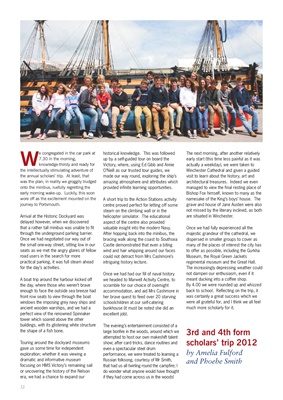
32
W
e congregated in the car park at
7.30 in the morning,
knowledge-thirsty and ready for
the intellectually stimulating adventure of
the annual scholars' trip. At least, that
was the plan; in reality we groggily trudged
onto the minibus, ruefully regretting the
early morning wake-up. Luckily, this soon
wore off as the excitement mounted on the
journey to Portsmouth.
Arrival at the Historic Dockyard was
delayed however, when we discovered
that a rather tall minibus was unable to fit
through the underground parking barrier.
Once we had negotiated our way out of
the small one-way street, sitting low in our
seats as we met the angry glares of fellow
road users in the search for more
practical parking, it was full steam ahead
for the day's activities.
A boat trip around the harbour kicked off
the day, where those who weren't brave
enough to face the outside sea breeze had
front row seats to view through the boat
windows the imposing grey navy ships and
ancient wooden warships, and we had a
perfect view of the renowned Spinnaker
tower which soared above the other
buildings, with its glistening white structure
the shape of a fish bone.
Touring around the dockyard museums
gave us some time for independent
exploration; whether it was viewing a
dramatic and informative museum
focusing on HMS Victory's remaining sail
or uncovering the history of the Nelson
era, we had a chance to expand our
historical knowledge. This was followed
up by a self-guided tour on board the
Victory, where, using Ed Gibb and Annie
O'Neill as our trusted tour guides, we
made our way round, exploring the ship's
amazing atmosphere and attributes which
provided infinite learning opportunities.
A short trip to the Action Stations activity
centre proved perfect for letting off some
steam on the climbing wall or in the
helicopter simulator. The educational
aspect of the centre also provided
valuable insight into the modern Navy.
After hopping back into the minibus, the
bracing walk along the coast to Southsea
Castle demonstrated that even a biting
wind and hair whipping around our faces
could not detract from Mrs Cashmore's
intriguing history lecture.
Once we had had our fill of naval history
we headed to Marwell Activity Centre, to
scramble for our choice of overnight
accommodation, and aid Mrs Cashmore in
her brave quest to feed over 20 starving
schoolchildren at our self-catering
bunkhouse (it must be noted she did an
excellent job).
The evening's entertainment consisted of a
large bonfire in the woods, around which we
attempted to host our own makeshift talent
show; after card tricks, dance routines and
even a spectacular steel drum
performance, we were treated to learning a
Russian folksong, courtesy of Mr Smith,
that had us all twirling round the campfire; I
do wonder what anyone would have thought
if they had come across us in the woods!
The next morning, after another relatively
early start (this time less painful as it was
actually a weekday), we were taken to
Winchester Cathedral and given a guided
visit to learn about the history, art and
architectural treasures. Indeed we even
managed to view the final resting place of
Bishop Fox himself, known to many as the
namesake of the King's boys' house. The
grave and house of Jane Austen were also
not missed by the literary inclined, as both
are situated in Winchester.
Once we had fully experienced all the
majestic grandeur of the cathedral, we
dispersed in smaller groups to cover as
many of the places of interest the city has
to offer as possible, including the Gurkha
Museum, the Royal Green Jackets
regimental museum and the Great Hall.
The increasingly depressing weather could
not dampen our enthusiasm, even if it
meant ducking into a coffee shop.
By 4.00 we were rounded up and whizzed
back to school. Reflecting on the trip, it
was certainly a great success which we
were all grateful for, and I think we all feel
much more scholarly for it.
3rd and 4th form
scholars' trip 2012
by Amelia Fulford
and Phoebe Smith